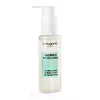What's inside
What's inside
 Key Ingredients
Key Ingredients

No key ingredients
 Benefits
Benefits

 Concerns
Concerns

 Ingredients Side-by-side
Ingredients Side-by-side

Water
Skin ConditioningCocamidopropyl Betaine
CleansingSodium Lauroyl Methyl Isethionate
CleansingSodium Methyl Oleoyl Taurate
CleansingCaprylhydroxamic Acid
Propanediol
SolventGlycerin
HumectantPanthenol
Skin ConditioningLauryl Glucoside
CleansingCoco-Glucoside
CleansingCalendula Officinalis Extract
Skin ConditioningSodium Benzoate
MaskingPotassium Sorbate
PreservativeSalix Alba Bark Extract
AstringentChamomilla Recutita Extract
Skin ConditioningWater, Cocamidopropyl Betaine, Sodium Lauroyl Methyl Isethionate, Sodium Methyl Oleoyl Taurate, Caprylhydroxamic Acid, Propanediol, Glycerin, Panthenol, Lauryl Glucoside, Coco-Glucoside, Calendula Officinalis Extract, Sodium Benzoate, Potassium Sorbate, Salix Alba Bark Extract, Chamomilla Recutita Extract
Aloe Barbadensis Leaf Water
MaskingCocamidopropyl Betaine
CleansingAcrylates Copolymer
Glycerin
HumectantSodium Chloride
MaskingNiacinamide
SmoothingHydroxypropyl Methylcellulose
Emulsion StabilisingCetyl Alcohol
EmollientStearyl Alcohol
EmollientAscorbyl Glucoside
AntioxidantGlutathione
Butylene Glycol
HumectantPotassium Cocoyl Glycinate
Propylene Glycol
HumectantDMDM Hydantoin
PreservativeLactobacillus/Milk Ferment Filtrate
Skin ConditioningPotassium Hydroxide
BufferingPotassium Cocoate
EmulsifyingTetrasodium EDTA
BHT
AntioxidantSodium Lauroyl Lactylate
EmulsifyingGlycyrrhiza Glabra Root Extract
BleachingCeramide NP
Skin ConditioningCeramide AP
Skin ConditioningPhytosphingosine
Skin ConditioningCholesterol
EmollientXanthan Gum
EmulsifyingCarbomer
Emulsion StabilisingBeetroot Red
Ceramide EOP
Skin ConditioningMaltodextrin
AbsorbentCitric Acid
BufferingAloe Barbadensis Leaf Water, Cocamidopropyl Betaine, Acrylates Copolymer, Glycerin, Sodium Chloride, Niacinamide, Hydroxypropyl Methylcellulose, Cetyl Alcohol, Stearyl Alcohol, Ascorbyl Glucoside, Glutathione, Butylene Glycol, Potassium Cocoyl Glycinate, Propylene Glycol, DMDM Hydantoin, Lactobacillus/Milk Ferment Filtrate, Potassium Hydroxide, Potassium Cocoate, Tetrasodium EDTA, BHT, Sodium Lauroyl Lactylate, Glycyrrhiza Glabra Root Extract, Ceramide NP, Ceramide AP, Phytosphingosine, Cholesterol, Xanthan Gum, Carbomer, Beetroot Red, Ceramide EOP, Maltodextrin, Citric Acid
Ingredients Explained
These ingredients are found in both products.
Ingredients higher up in an ingredient list are typically present in a larger amount.
Cocamidopropyl Betaine is a fatty acid created by mixing similar compounds in coconut oil and dimethylaminopropylamine, a compound with two amino groups.
This ingredient is a surfactant and cleanser. It helps gather the dirt, pollutants, and other impurities in your skin to be washed away. It also helps thicken a product and make the texture more creamy.
Being created from coconut oil means Cocamidopropyl Betaine is hydrating for the skin.
While Cocamidopropyl Betaine was believed to be an allergen, a study from 2012 disproved this. It found two compounds in unpure Cocamidopropyl Betaine to be the irritants: aminoamide and 3-dimethylaminopropylamine. High-grade and pure Cocamidopropyl Betaine did not induce allergic reactions during this study.
Learn more about Cocamidopropyl BetaineGlycerin is already naturally found in your skin. It helps moisturize and protect your skin.
A study from 2016 found glycerin to be more effective as a humectant than AHAs and hyaluronic acid.
As a humectant, it helps the skin stay hydrated by pulling moisture to your skin. The low molecular weight of glycerin allows it to pull moisture into the deeper layers of your skin.
Hydrated skin improves your skin barrier; Your skin barrier helps protect against irritants and bacteria.
Glycerin has also been found to have antimicrobial and antiviral properties. Due to these properties, glycerin is often used in wound and burn treatments.
In cosmetics, glycerin is usually derived from plants such as soybean or palm. However, it can also be sourced from animals, such as tallow or animal fat.
This ingredient is organic, colorless, odorless, and non-toxic.
Glycerin is the name for this ingredient in American English. British English uses Glycerol/Glycerine.
Learn more about Glycerin